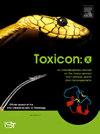Predictive analysis of B-cell antigenic epitopes in phospholipase D toxins from Loxosceles spiders
IF 2.8
Q2 TOXICOLOGY
引用次数: 0
Abstract
The Phospholipase D (PLD) toxin family, a major component of the Loxosceles spider venom, is a valuable biotechnological tool for developing antivenom treatment and diagnostic assays to overcome and prevent loxoscelism. However, there is limited knowledge about the antigenic structure of the PLD family or if sequence diversity correlates with antigenic variability. This study aimed to evaluate the possible antigenic diversity of PLDs sequences among different species of spiders of the Loxosceles genus through a predictive analysis of potential continuous and discontinuous antigenic epitopes of two phylogenetic interspecies clusters. Thus, L. laeta had higher amino acid sequence variation than other species, being classified into three phylogenetic clusters at the intra-specie level. Furthermore, multiple alignments of consensus PLD sequences from each Loxosceles species showed two different phylogenetic clusters at interspecies level depending on the amino acid conservation. For each cluster, at least nine continuous antigenic domains were identified, and depending on the phylogenetic cluster belonging to the Loxosceles species, the PLD continuous and discontinuous antigenic structure varies. Also, L. laeta PLDs vary significantly within the Loxosceles species and possess their own antigenic structure compared to other species with common continuous epitopes. Finally, the catalytic loop was identified as a common discontinuous epitope in the PLDs independently of the cluster or the class it belongs to. This antigenic diversity of PLD toxins could have implications for antibody recognition and should be considered in the design strategies for the development of serum treatments and diagnostic assays to detect Loxosceles venom.

蜘蛛磷脂酶D毒素b细胞抗原表位的预测分析
磷脂酶D (PLD)毒素家族是Loxosceles蜘蛛毒液的主要成分,是开发抗蛇毒治疗和诊断检测以克服和预防Loxosceles的有价值的生物技术工具。然而,关于PLD家族的抗原性结构或序列多样性是否与抗原性变异性相关的知识有限。本研究旨在通过对两个种间系统发育集群的潜在连续和不连续抗原表位的预测分析,评估不同种类Loxosceles属蜘蛛PLDs序列可能存在的抗原多样性。因此,在种内水平上,L. laeta的氨基酸序列变异程度高于其他物种,可分为3个系统发育集群。此外,每个Loxosceles物种的一致PLD序列的多次比对显示出两个不同的种间系统发育集群,这取决于氨基酸的保守性。对于每个集群,至少鉴定出9个连续的抗原结构域,并且根据属于Loxosceles物种的系统发育集群,PLD连续和不连续的抗原结构各不相同。此外,与其他具有共同连续表位的物种相比,L. laeta PLDs在Loxosceles物种中存在显著差异,并且具有自己的抗原结构。最后,催化环被鉴定为pld中常见的不连续表位,与它所属的簇或类无关。PLD毒素的这种抗原多样性可能对抗体识别有影响,应该在开发血清治疗和诊断检测Loxosceles毒液的设计策略中加以考虑。
本文章由计算机程序翻译,如有差异,请以英文原文为准。
求助全文
约1分钟内获得全文
求助全文
来源期刊

Toxicon: X
Pharmacology, Toxicology and Pharmaceutics-Toxicology
CiteScore
6.50
自引率
0.00%
发文量
33
审稿时长
14 weeks
 求助内容:
求助内容: 应助结果提醒方式:
应助结果提醒方式:


